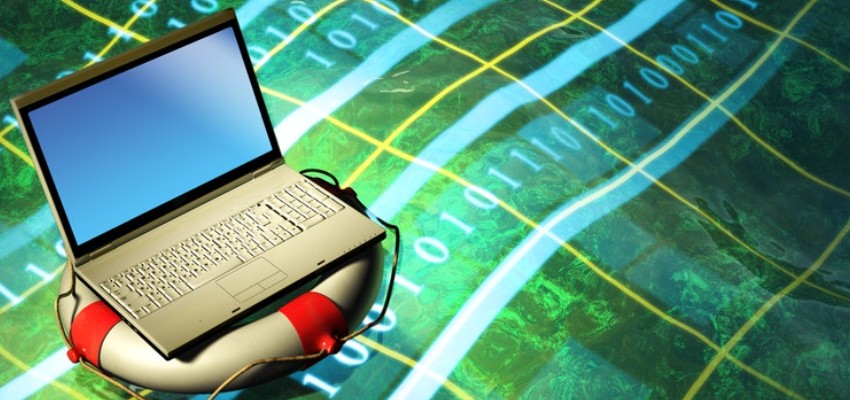|
|
Content Assessment: From Continuity to Culture? Preserving and Securing Ukrainian Public and Private Sector Data
Information - 92%
Insight - 90%
Relevance - 88%
Objectivity - 89%
Authority - 92%
90%
Excellent
A short percentage-based assessment of the qualitative benefit of the backgrounder post highlighting the challenges, considerations, and conduct by Ukraine in preserving and securing critical public and private sector data.
Editor’s Note: Highlighted by ComplexDiscovery prior to the start of the current Ukrainian Conflict, data embassies are an innovative approach to the digital continuity of nation-states as they serve as extensions of a nation-state’s cloud through state-owned server resources outside of the nation-state’s physical territorial boundaries. However, beyond the sovereignty-based need for data embassies, nation-states also need to plan and prepare to preserve and secure vital data ranging from government, education, and banking information to private sector registries and databases to ensure the continuity of commerce, coordination, and culture.
Provided in this post is a non-all-inclusive compilation of informational articles that may be helpful for cybersecurity, information governance, and legal discovery professionals seeking to learn more about the challenges, considerations, and conduct of preserving and securing public and private sector data in the wake of Ukraine’s current conflict with Russia.
Extract from the Wall Street Journal (June 14, 2022)
Ukraine Has Begun Moving Sensitive Data Outside Its Borders [1]
By Catherine Stupp
Ukrainian government officials have begun storing sensitive data outside the country to protect it from Russian cyber and physical assault, and are negotiating with several European nations to move more databases abroad.
Since the start of the war, around 150 registries from different government ministries and offices, or backup copies of them, have been moved abroad or are in discussions to be transferred, said George Dubinskiy, Ukraine’s deputy minister of digital transformation.
Previously, much of the government’s information trove was held in data centers in Ukraine, and needed first to be moved to the cloud before backup copies could be transferred, he said. The government prioritized important databases to move from old legacy data-storage systems, and created copies of those registries for storage in clouds outside Ukraine, he said.
“To be on the safe side, we want to have our backups abroad,” Mr. Dubinskiy said.
Extract from Amazon News (June 9, 2022)
Safeguarding Ukraine’s Data to Preserve its Present and Build its Future [2]
By Amazon Staff
Before the Russian invasion, Ukrainian law required certain government data and select private sector data to be stored in servers physically located in Ukraine. A week before the Russian military invaded the country, Ukraine’s parliament passed legislation to allow government and private sector data to be moved to the cloud. To accomplish that, Ukrainian leadership put out a public call for help. Amazon Web Services (AWS) was among the first organizations to respond.
Because of AWS’s previous experience in disaster response and activities helping Ukrainian organizations build their cybersecurity defenses in the lead up to the conflict, AWS technical experts (including solutions architects) were able to quickly establish secure communications with officials in government ministries in Kyiv and with Ukrainian representatives across Europe. On February 24, the day of the invasion, members of the AWS public sector team met with members of the Ukrainian government. The discussion focused on bringing AWS Snowball devices—ruggedized compute and storage hardware—into Ukraine to help secure, store, and transfer data to the cloud.
That conversation was on a Thursday. By Saturday morning, a set of Snowballs arrived in Kraków, Poland. Late that night and early into Sunday, they reached their destinations in Ukraine. These Snowball devices would become the foundation for the effort to preserve Ukraine’s data. Working across time zones and language barriers, AWS solutions architects partnered with their technical counterparts in Ukraine to quickly begin the process of securely moving critical Ukrainian government data to the cloud. Moving huge swaths of information from local servers to AWS data centers is called a “migration” in the cloud business.
As the conflict continues in its fourth month, AWS continues to add to over 10 petabytes (10 million gigabytes) of essential data already migrated from 27 Ukrainian ministries, 18 Ukrainian universities, the largest remote learning K–12 school (serving hundreds of thousands of displaced children), and dozens of other private sector companies. Right now there are 61 government data migrations to AWS, with more expected to come.
Extract from Amazon Website (June 22, 2022)
AWS Snowball [3]
Frequently Asked Questions
What is AWS Snowball? AWS Snowball is a service that provides secure, rugged devices, so you can bring AWS computing and storage capabilities to your edge environments, and transfer data into and out of AWS. Those rugged devices are commonly referred to as AWS Snowball or AWS Snowball Edge devices. Previously, AWS Snowball referred specifically to an early hardware version of these devices, however that model has been replaced by updated hardware. Now the AWS Snowball service operates with Snowball Edge devices, which include on-board computing capabilities as well as storage.
What is AWS Snowball Edge? AWS Snowball Edge is an edge computing and data transfer device provided by the AWS Snowball service. It has on-board storage and compute power that provides select AWS services for use in edge locations. Snowball Edge comes in two options, Storage Optimized and Compute Optimized, to support local data processing and collection in disconnected environments such as ships, windmills, and remote factories.
Extract from New/Lines Magazine (June 21, 2022)
As the War Drags On, a Race Is Afoot to Preserve Ukraine History [4]
By Gisela Salim
“There is a register of historical places that nobody can tear down — like my building,” said Ben Schmidt, a SUCHO volunteer and director of digital humanities at New York University who takes advantage of the school’s enviable faculty housing in downtown Manhattan. No system protects websites of cultural significance for a country, however. Even if the servers of these websites reside in safety, the companies that host them can take them down if their owners cannot pay rent. “Landmarking virtual sites is an idea that we have had in our minds for a while, but what’s happening now adds an urgency.”
Many Ukrainian websites would have disappeared if SUCHO had not saved a copy. On any day, between 14% and 20% of the listed websites are offline, though they often come back online when the connection stabilizes, but not always. Such was the case of the Kharkhiv State Archives, which contained the records of an entire region: births, marriages, documents of the people whom the Soviet Union banished to Siberia. Just hours after Majstorovic finished archiving the library’s website, the library itself collapsed and half of its website went offline.
“It was weird that library work suddenly became exciting,” said [Sebastian] Majstorovic. “Librarians do very important work that they get little credit for: archiving, saving, cataloging. But it’s usually not James Bond work.”
Extract from Articles of War (May 13, 2022)
The Ukraine Conflict and the Future of Digital Cultural Property [5]
By Ronald Alcala
In Ukraine, groups such as Saving Ukrainian Cultural Heritage Online (SUCHO) have been racing to save digital cultural information from destruction. Led by three cultural heritage professionals—Quinn Dombrowski, Anne E. Kijas, and Sebastian Majstorovic—and staffed by volunteers, SUCHO is dedicated to identifying and archiving “at-risk sites, digital content, and data in Ukrainian cultural heritage institutions.” The group relies on a combination of technologies, such as the Internet Archive’s Wayback Machine and the Browsertrix crawler, to crawl and archive the digital information of these organizations. Their goal is to back up digital heritage information, including content from websites, digital exhibits, and digitized journal articles, to ensure it is not irretrievably lost in the ongoing conflict.
Microsoft Digital Security Unit Report (April 27, 2022)
Special Report: Ukraine [6]
By Microsoft
This report details the cyber activity Microsoft has observed as part of the war in Ukraine, and the work we have done in collaboration with Ukrainian cybersecurity officials and private sector enterprises to defend against cyberattacks. Microsoft’s ongoing, daily engagement establishes that the cyber component of Russia’s assault on Ukraine has been destructive and relentless. The purpose of this report is to provide insights into the scope, scale, and methods of Russia’s use of cyber capabilities as part of the largescale “hybrid” war in Ukraine, to acknowledge the work of organizations in Ukraine defending against persistent adversaries, and to provide strategic recommendations to organizations worldwide.
Extract from the NATO Cooperative Cyber Defence Centre of Excellence (June 1, 2022)
The Rights to Privacy and Data Protection in Times of Armed Conflict [7]
Edited by Russell Buchan and Asaf Lubin
Contemporary warfare yields a profound impact on the rights to privacy and data protection. Technological advances in the fields of electronic surveillance, predictive algorithms, big data analytics, user-generated evidence, artificial intelligence, cloud storage, facial recognition, and cryptography are redefining the scope, nature, and contours of military operations. Yet, international humanitarian law offers very few, if any, lex specialis rules for the lawful processing, analysis, dissemination, and retention of personal information. This edited anthology offers a pioneering account of the current and potential future application of digital rights in armed conflict.
Backgrounder (February 9, 2022)
Data Embassies: Sovereignty, Security, and Continuity for Nation-States [8]
By ComplexDiscovery
The data embassy approach is unique as nation-states historically have stored their information within their physical territorial boundaries. This recent approach provides the capability for a nation-state to host data and service resources in a secure data center outside its physical territorial borders and operate those resources in times of crisis ranging from large-scale cyberattacks to military invasions by hostile nation-states. This approach is also designed to provide sovereignty, security, and continuity for nation-states in situations where the operation of hosted data and service resources inside physical territorial boundaries is diminished, denied, or destroyed. By having an established data embassy, a nation-state can expatriate government-critical data and services to a diplomatically-secure location, enabling continuity of government with the protections of immunity and inviolability.
References
- Stupp, C. (2022). Ukraine Has Begun Moving Sensitive Data Outside Its Borders. The Wall Street Journal. Retrieved 22 June 2022, from https://www.wsj.com/articles/ukraine-has-begun-moving-sensitive-data-outside-its-borders-11655199002.
- Safeguarding Ukraine’s data to preserve its present and build its future. US About Amazon. (2022). Retrieved 22 June 2022, from https://www.aboutamazon.com/news/aws/safeguarding-ukraines-data-to-preserve-its-present-and-build-its-future.
- AWS Snowball. Amazon Web Services, Inc. (2022). Retrieved 22 June 2022, from https://aws.amazon.com/snowball/.
- Salim, G. (2022). As the War Drags On, a Race Is Afoot to Preserve Ukraine History. New Lines Magazine. Retrieved 22 June 2022, from https://newlinesmag.com/reportage/as-the-war-drags-on-a-race-is-afoot-to-preserve-ukraine-history/.
- Alcala, R. (2022). Ukraine Symposium – The Ukraine Conflict and the Future of Digital Cultural Property – Lieber Institute West Point. Lieber Institute West Point. Retrieved 22 June 2022, from https://lieber.westpoint.edu/ukraine-conflict-future-digital-cultural-property/.
- Special Report: Ukraine. Complexdiscovery.com. (2022). Retrieved 22 June 2022, from https://complexdiscovery.com/wp-content/uploads/2022/04/Microsoft-Ukraine-Special-Report-April-2022.pdf.
- Buchan, R., & Lubin, A. (2022). The Rights to Privacy and Data Protection in Times of Armed Conflict. Ccdcoe.org. Retrieved 22 June 2022, from https://ccdcoe.org/library/publications/the-rights-to-privacy-and-data-protection-in-times-of-armed-conflict/.
- Data Embassies: Sovereignty, Security, and Continuity for Nation-States. ComplexDiscovery. (2022). Retrieved 22 June 2022, from https://complexdiscovery.com/data-embassies-sovereignty-security-and-continuity-for-nation-states/.
Additional Reading
- [Annual Update] International Cyber Law in Practice: Interactive Toolkit
- Defining Cyber Discovery? A Definition and Framework
Source: ComplexDiscovery



























